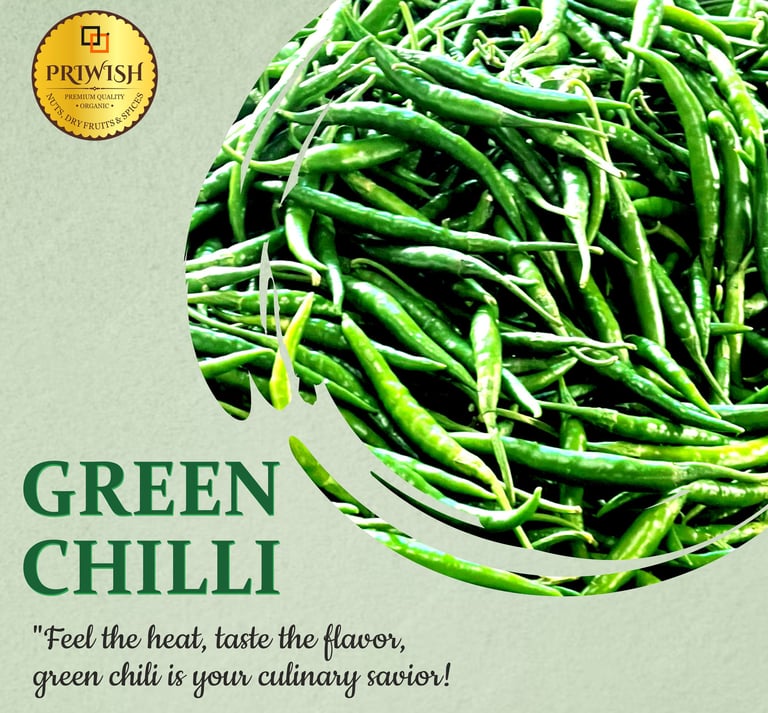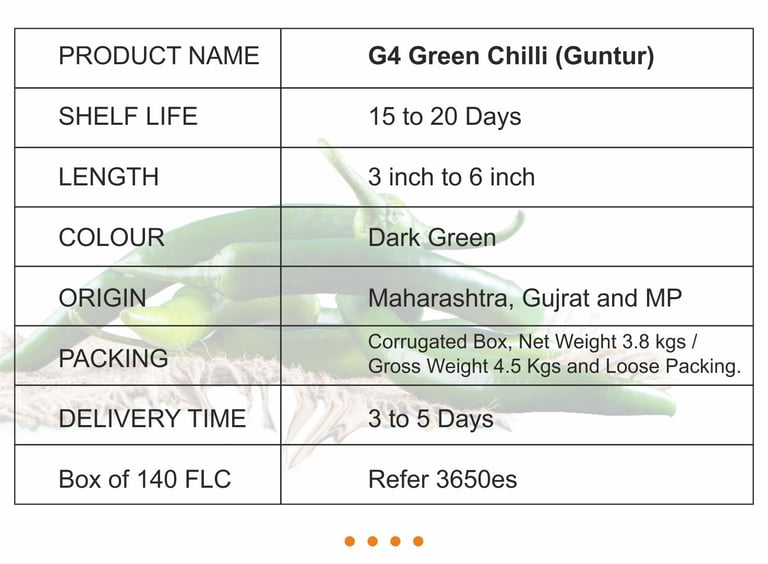1. Green Chili Varieties:
India is known for its diverse varieties of green chillies, each with its unique flavor, heat level, and culinary uses. Some of the common types of fresh green chillies found in India include:
1. Bhut Jolokia (Ghost Pepper): One of the hottest chillies in the world, Bhut Jolokia is native to Assam and is widely used in pickles, chutneys, and spice blends.
2. Green Chilli (Capsicum annuum): The generic green chilli is commonly used in Indian cuisine and comes in various sizes. It adds heat to dishes without overpowering the flavor.
3. Banana Pepper (Mild Chili): These long, slender peppers are mild and often used in salads, sandwiches, and as a topping for pizzas.
4. Jwala Chilli: Native to Gujarat, Jwala chillies are medium-hot and are commonly used in Indian snacks like pakoras and bhajis.
5. Kashmiri Chilli: Known for its vibrant red color, Kashmiri chilli is milder compared to some other varieties. It is often used to add color to dishes like biryanis and curries.
6. Serrano Pepper: These are moderately hot chillies and are often used in Indian and Mexican cuisines.
7. Byadagi Chilli: Native to Karnataka, Byadagi chillies are known for their deep red color and are often used in South Indian dishes to add both color and flavor.
8. Guntur Chilli: Grown in the Guntur region of Andhra Pradesh, these chillies are known for their high heat levels and are commonly used in spicy Andhra cuisine.
9. Kanthari (Bird's Eye Chilli): Small and fiery, Kanthari chillies are used in various South Indian dishes, pickles, and chutneys.
10. Kashmiri Mirch (Kashmiri Red Chili): While available in both dried and fresh forms, the fresh Kashmiri Mirch is mildly hot and is used for its vibrant color in Kashmiri cuisine.
These are just a few examples, and there are many more regional varieties across India, each contributing to the rich and diverse flavors of Indian cuisine. The heat level can vary widely between these chillies, so it's essential to choose the right one based on your preference for spiciness in your dishes.
Certainly! Let's delve into more detail about some of the mentioned chillies:
1. Bhut Jolokia (Ghost Pepper):
- Origin: Assam, India.
- Scoville Heat Units (SHU): Extremely high, ranging from 800,000 to over 1,000,000 SHU.
- Characteristics: Bhut Jolokia is one of the spiciest chillies globally, with a smoky and fruity flavor. It is often used in very small quantities due to its intense heat.
2. Green Chilli (Capsicum annuum):
- Varieties: There are numerous varieties of green chillies, including those with a mild to moderate heat level.
- Characteristics: Green chillies are a staple in Indian cuisine, providing heat and flavor to various dishes. The heat level can vary, and they are commonly used in both raw and cooked forms.
3. Jwala Chilli:
- Origin: Gujarat, India.
- Scoville Heat Units (SHU): Ranges from 30,000 to 50,000 SHU.
- Characteristics: Jwala chillies are medium-hot with a distinctive aroma. They are often used in making Indian snacks like pakoras and bhajis.
4. Kashmiri Chilli:
- Origin: Kashmir, India.
- Scoville Heat Units (SHU): Mild, ranging from 1,000 to 2,000 SHU.
- Characteristics: Kashmiri chillies are known for their deep red color and are used more for their vibrant appearance than their heat. They impart a mild, slightly sweet flavor to dishes.
5. Byadagi Chilli:
- Origin: Karnataka, India.
- Scoville Heat Units (SHU): Ranges from 2,500 to 5,000 SHU.
- Characteristics: Byadagi chillies are known for their deep red color, mild heat, and a slightly sweet taste. They are often used in South Indian cuisine to add color and flavor.
6. Guntur Chilli:
- Origin: Guntur region of Andhra Pradesh, India.
- Scoville Heat Units (SHU): Varies widely; some varieties can be very hot.
- Characteristics: Guntur chillies are known for their high heat levels and are a crucial component of spicy Andhra cuisine. They are used in pickles, curries, and spice blends.
7. Canthari (Bird's Eye Chilli):
- Origin: South India.
- Scoville Heat Units (SHU): Moderately high, ranging from 50,000 to 100,000 SHU.
- Characteristics: Kanthari chillies are small, fiery, and often used in South Indian dishes, chutneys, and pickles. They add a significant amount of heat to the dishes.
These details provide a glimpse into the diverse world of Indian chillies, showcasing variations in heat levels, flavors, and culinary uses across different regions. Keep in mind that the heat level can vary even within the same variety based on factors like growing conditions and cultivation practices.
2. Size Classification:
a. Extra Long: Length exceeds 4 inches.
b. Long: Length ranges from 3 to 4 inches.
c. Medium: Length varies from 2 to 3 inches.
d. Short: Length is less than 2 inches.
3. Quality Parameters:
a. Color: Vibrant green hue indicating freshness and maturity.
b. Texture: Firm, unblemished skin, free from wrinkles or soft spots.
c. Heat Level: As per the variety, ranging from mild to hot.
4. Packaging:
a. Bulk Packaging: Mesh bags or ventilated cartons ensuring proper airflow.
b. Consumer Packaging: Customizable packaging options available for retail needs.
5. Cultivation Practices:
a. Region: Sourced from regions renowned for cultivating high-quality green chillies, ensuring optimal climatic conditions.
b. Organic Farming: Priwish Enterprises promotes sustainable and organic farming practices for a healthier and eco-friendly product.
6. Harvesting:
a. Timing: Green chillies are harvested at the peak of freshness to capture their intense flavor and heat.
b. Maturity: Only fully matured chillies are picked to ensure maximum heat intensity
7. Scoville Heat Units (SHU):
a. Banana Peppers: 0-500 SHU.
b. Jwala Chilies: 30,000-50,000 SHU.
c. Serrano Peppers: 10,000-25,000 SHU.
8. Certification:
a. Quality Certification: Our exported green chillies adhere to international quality standards and are accompanied by relevant certifications.
b. Organic Certification: Priwish Enterprises offers green chillies cultivated through organic farming practices for health-conscious consumers.
9. Usage Recommendations:
a. Banana Peppers: Ideal for pickling, stuffing, and garnishing.
b. Jwala Chilies: Perfect for Indian dishes, pickles, and culinary creations requiring medium to high heat.
c. Serrano Peppers: Versatile in Indian, Mexican, and international cuisines, offering a moderate level of heat.
Priwish Enterprises ensures that our exported Indian Green Chillies meet the highest standards in terms of variety, quality, and compliance. We take pride in delivering a spice that adds both flavor and heat to culinary creations around the world.
Here are some general characteristics of Guntur chillies:
1. Origin: Guntur, Andhra Pradesh, India.
2. Scoville Heat Units (SHU): The heat level of Guntur chillies can vary widely, and some varieties are known to be very hot, measuring in the range of 50,000 to 100,000 SHU or even higher.
3. Appearance: Guntur chillies are often long and slender, with a vibrant green color when fresh. As they mature, they may turn red.
4. Flavor Profile: Guntur chillies are prized not only for their heat but also for their distinctive flavor. They contribute a unique spiciness to dishes, enhancing the overall taste.
5. Culinary Uses: Guntur chillies are used in various forms, including fresh, dried, and in powder form. They are a key ingredient in many pickles, chutneys, and spice blends. The dried and powdered forms are commonly used to add heat and color to curries, stews, and other Indian dishes.
6. Cultivation: The Guntur region has a suitable climate for the cultivation of chillies, and farmers in the area often specialize in growing different varieties of chillies. The region's soil and weather conditions contribute to the unique characteristics of Guntur chillies.
….




....
© 2017 - 2025 Priwish Enterprises I All Rights Reserved.
Quick Links
